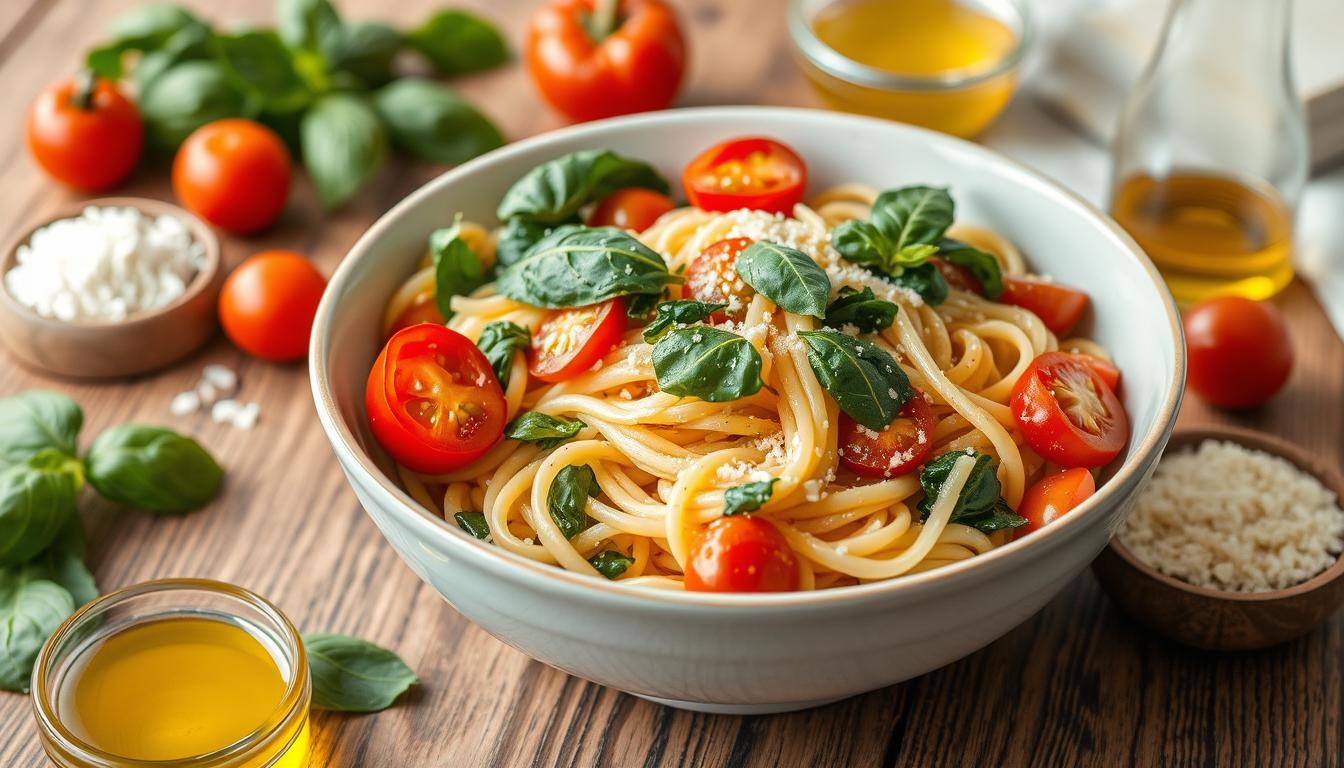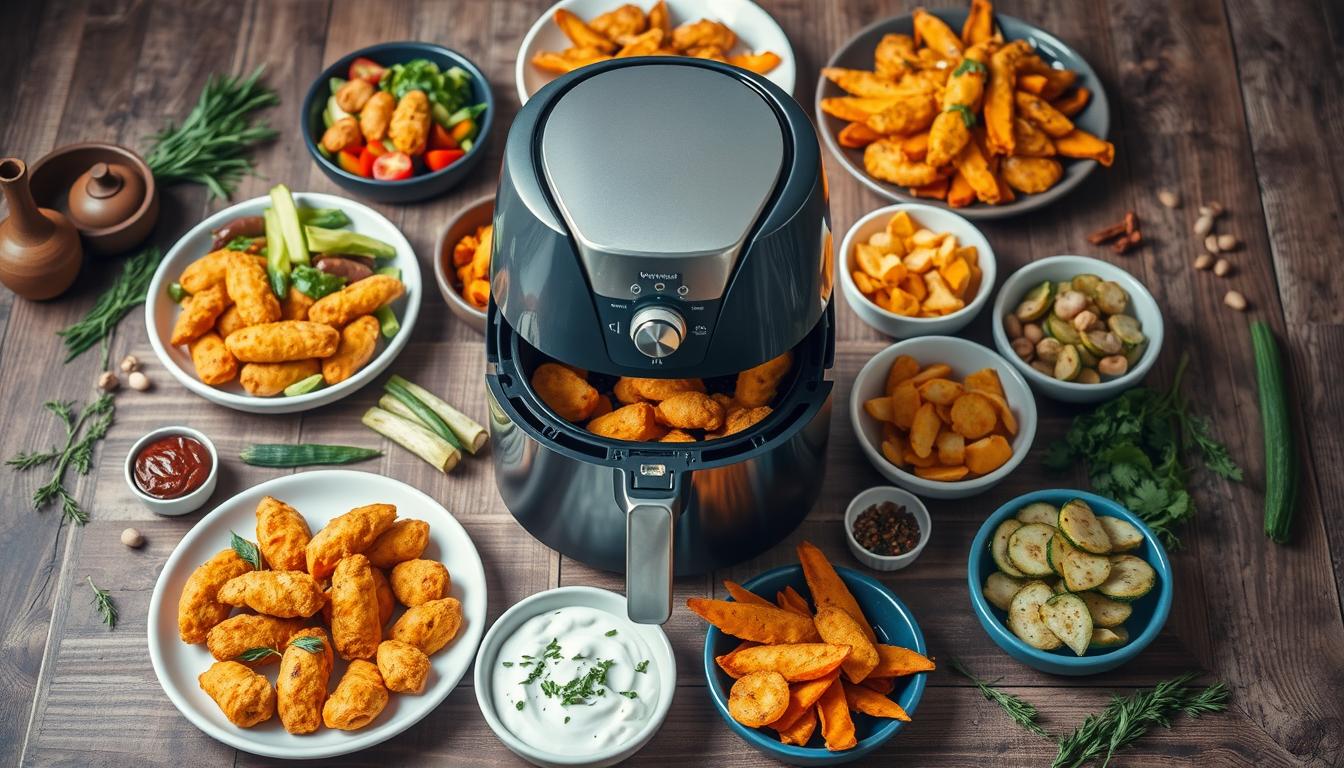Did you know that about 80% of people with irritable bowel syndrome (IBS) also have small intestinal bacterial overgrowth (SIBO)? This is a big reason why we need special SIBO-friendly recipes. Our collection of SIBO recipes is here to help. They are made to ease your digestive issues, reduce inflammation, and balance your gut.
Understanding SIBO and Its Impact on Digestive Health
Small intestinal bacterial overgrowth (SIBO) happens when bacteria from the colon grow in the small intestine. This can cause stomach pain, bloating, diarrhea, and not getting enough nutrients. Things like taking certain medicines or having surgery can make SIBO more likely.
Common SIBO Symptoms and Manifestations
SIBO symptoms include a bloated stomach, pain, and changes in bowel movements. If not treated, it can lead to vitamin and mineral deficiencies. In some cases, it can even cause D-lactic acidosis.
How Diet Affects Bacterial Overgrowth
Eating less of certain carbs can help manage SIBO. Diets like the low-FODMAP diet can help reduce symptoms like bloating and pain.
The Role of Nutrition in SIBO Management
Good nutrition is key for SIBO patients. Antibiotics might not work for everyone, leading to symptoms coming back. An elemental diet is the best diet for treating SIBO when antibiotics fail. Also, eating foods high in fiber and practicing good eating habits can help.
| Nutrition Considerations for SIBO Management | Impact |
|---|---|
| Elemental diet | The only proven dietary approach to treat SIBO when antibiotics are ineffective |
| Low-FODMAP diet | Shown to reduce abdominal bloating and pain in individuals with IBS |
| Fiber-rich foods | Can support healthy gut bacteria and reduce various gastrointestinal symptoms |
| Probiotics | Unlikely to help treat SIBO and may even increase the risk of SIBO recurrence |
| Animal-based proteins | Can help lower SIBO-related gases, such as methane and hydrogen |
Knowing how SIBO affects digestion and the importance of diet and nutrition can help improve gut health.
The SIBO-Specific Diet Fundamentals
The SIBO-Specific Diet helps manage small intestinal bacterial overgrowth (SIBO). It avoids foods that make SIBO worse, like grains and potatoes. Instead, it focuses on low-FODMAP veggies, meats, and healthy fats.
This diet aims to starve the bad bacteria by cutting out their favorite foods. It helps reduce symptoms like belly pain and weight loss. Following this diet can help heal the gut and reduce liver stress.
| Allowed on the SIBO-Specific Diet | Restricted on the SIBO-Specific Diet |
|---|---|
|
|
Following the SIBO-Specific Diet is a proactive step for managing SIBO symptoms. It supports gut health and can improve digestion and overall well-being.
“The SIBO-Specific Diet is a powerful tool for managing SIBO symptoms and promoting gut healing. By eliminating the foods that feed the overgrown bacteria, individuals can take an important step towards reclaiming their digestive health.” – Gut Health Expert
Essential Kitchen Ingredients for SIBO Recipes
Starting the SIBO diet can be tricky, but the right kitchen tools help a lot. First, fill your pantry with low-FODMAP veggies and fruits. Think leafy greens, carrots, zucchini, and berries. Also, add pastured meats, frozen wild seafood, and plant-based protein powders to your list.
Healthy fats like avocado, olive oil, and nut butters are key. They help absorb nutrients and keep you full.
For seasonings, choose SIBO-friendly options like coconut aminos and garlic-infused olive oil. Bone broth is great for soups and sauces. Nutritional yeast adds a rich, savory taste to your food.
Approved Low-FODMAP Vegetables and Fruits
- Leafy greens (spinach, kale, arugula)
- Carrots
- Zucchini
- Berries (blueberries, raspberries, strawberries)
- Citrus fruits (oranges, lemons, limes)
Protein Sources and Healthy Fats
- Pastured meats (chicken, turkey, beef, pork)
- Frozen wild-caught seafood
- Plant-based protein powders
- Avocado
- Olive oil
- Nut butters
Permitted Seasonings and Condiments
- Coconut aminos
- Garlic-infused olive oil
- Mustard
- Bone broth
- Nutritional yeast
With these ingredients, you can make tasty SIBO recipes. Use a Low-FODMAP food guide to pick the right foods for you. Planning ahead lets you make meals that are good for your gut and taste great.
Getting Started with SIBO Recipes
Starting with ibs-friendly cooking and fermentation-friendly foods can feel hard. But, with the right steps, you can make tasty meals that help your gut. First, learn about SIBO-approved foods and make a meal plan that fits your needs.
Look for SIBO-specific recipe resources to find new dishes. Join online groups to meet others on the SIBO diet and share recipes. Choose foods that fight inflammation, like green juices, bone broths, and easy-to-digest proteins, to help heal your gut.
- Explore SIBO-friendly meal plans and recipes to get started.
- Connect with online communities for support and recipe inspiration.
- Prioritize anti-inflammatory, easy-to-digest ingredients in your meals.
“Nourishing your body with the right foods can make a significant difference in managing SIBO and improving your overall digestive health.”
Remember, the secret to great SIBO-friendly cooking is to listen to your body. Try new ingredients and find recipes that you love. With a bit of practice, you’ll make meals that are both tasty and good for your gut.
Breakfast Options for SIBO Healing
Starting your day with a SIBO-friendly diet is easy. Breakfast is a great time to eat foods that help your gut heal. Try prebiotic recipes and gluten-free options for a healthy start.
Quick Morning Meals
For a quick and tasty SIBO-friendly breakfast, make a veggie-packed frittata. Use spinach, bell peppers, and green onion tops. Add avocado or berries for a balanced meal.
Make-Ahead Breakfast Ideas
Meal prepping is a big help for SIBO management. Make chia seed pudding with coconut milk and low-FODMAP fruits. Gluten-free granola with nuts and seeds is also a great make-ahead option.
Smoothie and Beverage Recipes
Smoothies are great for adding prebiotics to your diet. Mix low-FODMAP fruits, leafy greens, avocado, and nut butters. Add healthy fats and protein for fullness.
Trying these SIBO-friendly breakfasts can help your body and gut health. A balanced diet is key to managing SIBO and feeling better.
| SIBO-Friendly Breakfast Recipes | Key Ingredients |
|---|---|
| Cinnamon Blueberry Rice Flour Pancakes | Rice flour, blueberries, cinnamon, coconut milk |
| Coconut Lemon Scallops | Scallops, coconut milk, lemon, herbs |
| Chia Seed Pudding | Chia seeds, coconut milk, low-FODMAP fruits |
| Veggie Frittata | Eggs, spinach, bell peppers, green onion tops |
“Breakfast is the most important meal of the day, when you have SIBO. Eating SIBO-friendly foods in the morning helps your body heal and thrive.”
– Shivan Sarna, author of “Healing SIBO”
Nutrient-Dense Main Course SIBO Recipes
Making healthy main dishes for SIBO is key for gut health. Use lean proteins, low-FODMAP veggies, and healthy fats for a balanced meal. Add herbs and spices for flavor and health perks. These recipes help you manage your digestive health while eating well.
Try our Grilled Chicken with Roasted Zucchini and Olive Oil. It’s juicy chicken, caramelized zucchini, and olive oil for a tasty, anti-inflammatory dish. Or, go for our Baked Salmon with Spaghetti Squash and Pesto. It’s salmon, spaghetti squash, and pesto for a nutrient boost.
| Recipe | Rating | Reviews |
|---|---|---|
| Turmeric Beef Stew | 4.8 | 105 |
| Collagen Green Smoothie | 4.6 | 57 |
| Pineapple Turmeric Smoothie | 4.5 | 100 |
| Strawberry Coconut Collagen Smoothie | 4.5 | 43 |
| Kiwi Lime Smoothie | 4.4 | 138 |
These recipes show you can eat tasty, gut-friendly meals on the SIBO diet. Use clean ingredients and careful cooking to nourish your body and aid digestion.
“I’ve found these SIBO-friendly recipes to be a game-changer in managing my symptoms. The meals are delicious and leave me feeling satisfied and energized.”
A good SIBO diet includes many foods that help your gut and overall health. Try these main dishes and start your journey to better digestion.
Anti-Inflammatory Side Dishes and Snacks
Adding anti-inflammatory side dishes and snacks to your diet can change your life. These foods are full of nutrients that help your gut and fight inflammation. This is key to beating chronic diseases.
Vegetable-Based Sides
Try roasted carrots, sautéed spinach, and cucumber salads. They are great for your gut and packed with good stuff. These foods are full of antioxidants, fiber, and vitamins to make you healthy.
SIBO-Friendly Snack Options
For snacks, make homemade trail mix with nuts and seeds. Or try carrot sticks with guacamole or small pieces of cheese with low-FODMAP fruits. These snacks give you energy and keep you full.
| Anti-Inflammatory Snack | Key Nutrients |
|---|---|
| Air-Popped Popcorn | Fiber, Polyphenols |
| Sliced Apples | Fiber, Vitamin C |
| Bell Peppers with Hummus | Fiber, Vitamin C, Healthy Fats |
| Unsalted Walnuts | Omega-3 Fatty Acids, Fiber, Protein |
| Cucumber Slices with Hummus | Fiber, Vitamin K, Healthy Fats |
These foods are whole and unprocessed. They are full of prebiotics, probiotics, and nutrients good for your gut. Eating these can help your digestive system and improve your health.
“Nourishing your body with nutrient-dense, anti-inflammatory foods can make a significant difference in your digestive wellness and overall well-being.”
Meal Planning and Preparation Tips
Planning your meals ahead can make sticking to sibo recipes and gut-friendly meals easy. Use a calendar or meal planning app to map out your weekly meals. This helps you eat a balanced diet and saves time during the week.
Batch cooking on weekends is a great idea. Cook big batches of proteins, grains, and veggies. Then, you can reheat them for quick meals all week. Make a shopping list early to avoid last-minute grocery runs.
Keep sibo-friendly snacks and drinks ready. Think hard-boiled eggs, nut butter with celery, or infused water. This way, you won’t grab bad foods that hurt your stomach.
Try new recipes and mix up flavors. The more variety, the better you’ll stick to a healthy diet. With some planning, you can enjoy tasty, healthy meals that help your gut.
Conclusion
The SIBO-Specific Diet can really help you feel better and heal your gut. It’s vital to work with a healthcare expert to make sure you get the right food. As you start to feel better, you can slowly add back foods to see what you can handle.
Healing takes time, and sticking to the diet is important for managing SIBO. This way, you can control your symptoms and work on healing your gut.
Even though SIBO can be tough, this guide offers recipes and tips to help you manage it. By eating foods that are good for your gut and following the SIBO diet, you can lessen your symptoms. With patience and the right steps, you can get your health back and live a better life.
Everyone’s journey to better gut health is different. What works for one person might not work for another. So, be ready to try new things and find what works best for you.
By focusing on foods that are good for your gut and sticking to the SIBO diet, you’re on the right path. This can lead to a happier, healthier you.
Are you looking for something new to bake? There’s a whole world of delicious recipes out there waiting to be discovered. From classic favorites to innovative twists, there’s a recipe for every taste and occasion
FAQ
What is the SIBO-Specific Diet?
The SIBO-Specific Diet combines Low-FODMAP and Specific Carbohydrate Diet (SCD) principles. It helps manage symptoms and heal the gut in cases of small intestinal bacterial overgrowth (SIBO). It’s a very restrictive diet. You should use it alongside other treatments under a healthcare professional’s guidance.
What are the common symptoms of SIBO?
Common symptoms of SIBO include abdominal distention and pain. You might also feel discomfort, have diarrhea or constipation, and lose weight. It can also cause nutrient deficiencies, like iron, B-12, and vitamins A, D, and K.
How does the SIBO-Specific Diet work?
The diet reduces fermentable carbohydrates that feed bacterial overgrowth. It excludes grains, most legumes, and high FODMAP fruits and vegetables. It also avoids foods that can make SIBO symptoms worse.
What foods are allowed on the SIBO-Specific Diet?
Allowed foods include low-FODMAP fruits and vegetables, pastured meats, and healthy fats. You can also have fermented dairy, most nuts and seeds, and limited amounts of lentils, lima beans, raw honey, and stevia.
How can I get started with SIBO-friendly recipes?
Start by learning about allowed foods and creating a meal plan. Use SIBO-specific recipes and meal plans. Join online communities for support and more recipe ideas.
What are some SIBO-friendly breakfast options?
Good breakfast choices include smoothies with low-FODMAP fruits and vegetables. You can also have chia seed puddings with coconut milk and eggs with low-FODMAP veggies.
How can I incorporate anti-inflammatory foods into my SIBO diet?
Eat fresh green juices, broths, and lightly cooked vegetables. Also, choose easy-to-digest proteins to reduce inflammation and promote gut healing.
What tips can help with SIBO meal planning and preparation?
Meal prepping, batch cooking, and using a meal planning calendar can save time. They help ensure you have nutritious, SIBO-friendly meals all week.



























